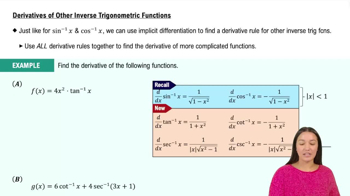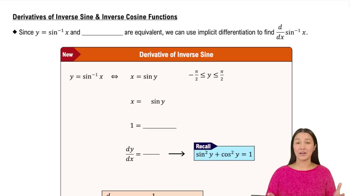Find the derivative of the given function.
Table of contents
- 0. Functions7h 54m
- Introduction to Functions16m
- Piecewise Functions10m
- Properties of Functions9m
- Common Functions1h 8m
- Transformations5m
- Combining Functions27m
- Exponent rules32m
- Exponential Functions28m
- Logarithmic Functions24m
- Properties of Logarithms36m
- Exponential & Logarithmic Equations35m
- Introduction to Trigonometric Functions38m
- Graphs of Trigonometric Functions44m
- Trigonometric Identities47m
- Inverse Trigonometric Functions48m
- 1. Limits and Continuity2h 2m
- 2. Intro to Derivatives1h 33m
- 3. Techniques of Differentiation3h 18m
- 4. Applications of Derivatives2h 38m
- 5. Graphical Applications of Derivatives6h 2m
- 6. Derivatives of Inverse, Exponential, & Logarithmic Functions2h 37m
- 7. Antiderivatives & Indefinite Integrals1h 26m
- 8. Definite Integrals4h 44m
- 9. Graphical Applications of Integrals2h 27m
- 10. Physics Applications of Integrals 3h 16m
- 11. Integrals of Inverse, Exponential, & Logarithmic Functions2h 31m
- 12. Techniques of Integration7h 41m
- 13. Intro to Differential Equations2h 55m
- 14. Sequences & Series5h 36m
- 15. Power Series2h 19m
- 16. Parametric Equations & Polar Coordinates7h 58m
6. Derivatives of Inverse, Exponential, & Logarithmic Functions
Derivatives of Inverse Trigonometric Functions
Problem 3.10.4
Textbook Question
How are the derivatives of sin^−1 x and cos^−1 x related?
 Verified step by step guidance
Verified step by step guidance1
To find the derivatives of sin^−1(x) and cos^−1(x), we start by recalling their definitions. The function sin^−1(x), also known as arcsin(x), is the inverse of the sine function, and cos^−1(x), or arccos(x), is the inverse of the cosine function.
The derivative of sin^−1(x) with respect to x is given by the formula: . This formula arises from implicit differentiation and the Pythagorean identity.
Similarly, the derivative of cos^−1(x) with respect to x is: . Notice the negative sign in the numerator, which is due to the derivative of the cosine function being negative.
The relationship between these derivatives can be understood by observing that they are negatives of each other. This is because the sum of sin^−1(x) and cos^−1(x) is a constant, specifically , and the derivative of a constant is zero.
Therefore, the derivatives of sin^−1(x) and cos^−1(x) are related by the equation: = -, reflecting their inverse relationship.
 Verified video answer for a similar problem:
Verified video answer for a similar problem:This video solution was recommended by our tutors as helpful for the problem above
Video duration:
3mPlay a video:
Was this helpful?
Key Concepts
Here are the essential concepts you must grasp in order to answer the question correctly.
Inverse Trigonometric Functions
Inverse trigonometric functions, such as sin^−1(x) and cos^−1(x), are the functions that reverse the action of the sine and cosine functions, respectively. They take a value from the range of the sine or cosine function and return an angle. Understanding these functions is crucial for analyzing their derivatives and their relationships.
Recommended video:

Derivatives of Other Inverse Trigonometric Functions
Derivative of Inverse Functions
The derivative of an inverse function can be found using the formula: if y = f^−1(x), then dy/dx = 1/(df/dy). This principle is essential for calculating the derivatives of sin^−1(x) and cos^−1(x), as it allows us to relate the derivatives of these inverse functions to the derivatives of their corresponding trigonometric functions.
Recommended video:

Derivatives of Inverse Sine & Inverse Cosine
Relationship Between Derivatives
The derivatives of sin^−1(x) and cos^−1(x) are related through the identity: d/dx[sin^−1(x)] + d/dx[cos^−1(x)] = 0. This indicates that the rate of change of these two functions is inversely related, reflecting the complementary nature of sine and cosine. Understanding this relationship helps in solving problems involving both functions.
Recommended video:
Guided course

Converting between Degrees & Radians

 7:26m
7:26mWatch next
Master Derivatives of Inverse Sine & Inverse Cosine with a bite sized video explanation from Patrick
Start learningRelated Videos
Related Practice
Multiple Choice
